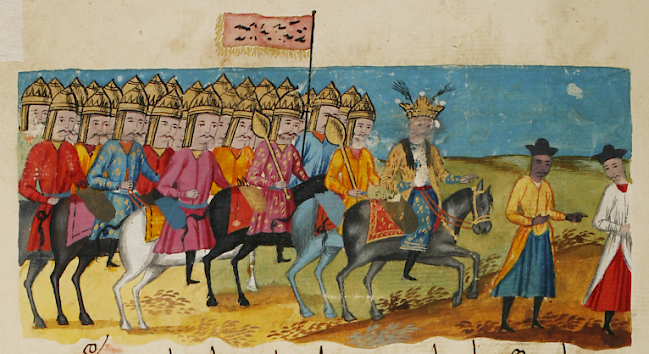The Byzantine Invasion of Persia in the Shahnameh
The Byzantine war with the Sassanid Empire in the seventh-century has been covered by historians and chroniclers. But perhaps more people are familiar with the version told in the Shahnameh, the great Persian epic poem. It tells a very different story of what happened when Emperor Heraclius launched his invasion.

Over 50,000 lines long, it took its poet Ferdowsi over thirty years to write the Shahnameh. It covers a vast amount of history, beginning with the creation of the world, following thousands of years of history, and ending with the Islamic conquest of Persia in the seventh-century. Completed around the year 1010, the poem has been hugely influential on the literature and language of Iran.
Ferdowsi aimed to create a more romantic tale, filled with heroes and villains, than one based on historical accuracy, and he made use of many written and oral sources that no longer exist, so he often presents unique accounts on events of the past. For example, his story about the Byzantine war with the Sassanid Empire during the years 602-628 is very different. It begins by explaining that the Sassanid ruler Khosrow II, here referred to as Khosrow Parviz, had gone from a good ruler to an evil one:
Despite his splendid throne, the great palace he built at Ctesiphon, and all his imperial glory, the world’s king was dissatisfied, and he raised dust clouds of strife over Iran and Turan. This king who had been so just became unjust, and he rejoiced in the injustice of his inferiors.
Ferdowsi then adds a few words about how his underlings were evil and causing problems, including Shahrbaraz, an important general. In the Shahnameh he is called Goraz, and the poet describes him as:
a man devoid of virtue, who fulfilled all Khosrow Parviz’s dreams and desires, and guarded the frontier against Byzantium. His mind was a demon’s, unjust and shameless, and when the once-just king became unjust, he was the first to betray Persia.
After allying with Khosrow’s chamberlain, Goraz begins a plot to overthrow his ruler. He writes to the Byzantine emperor, telling him “Rise now, and take Persia; if you do, I will be the first two come your aid.” This prompts the Byzantines to launch an invasion and reach the borders with Persia.
The rest of the story is told in the Shahnameh:
When the king heard of this serious development, he dismissed it as of no importance. He knew it was Goraz’s doing, and that he had been in secret communication with the Byzantine emperor. Earlier he had summoned Goraz to the court but Goraz made excuses and acted as if the king could not enforce his orders, even though he was afraid of him. The king sat in council with the Persian nobles, and they considered various ways to rid themselves of this problem. Then the king had a clever notion: he wrote a letter to Goraz saying, “I’m delighted with what you have done, and have praised you before our nobles. When you receive this letter may it brighten your dark spirits. Wait with your forces where you are until I advance, and with army on this side and another on that, we shall trap the Byzantine emperor between us. We’ll bring him back as a prisoner to Persia, and take all his army into captivity.”
Then the king chose a cunning courtier, someone who could act as a spy, and said to him, “See that one of the Byzantine scouts catches sight of you and questions you. Then he’ll take you to the emperor, or to their army’s commander. When you’re asked who you are, refuse to answer, then say, “I’m just a poor man trying to make a living, and I’ve traveled a long way to deliver this letter to Goraz.’ Tie the letter to your right arm, and if they take it from you, so much the better.”
The man tied the letter as instructed and left the court. As he approached the Byzantine marches, a man caught sight of him and took him, with his face covered in dust, his cheeks sallow, and his lips purple, before the emperor. The emperor addressed him, “Where is Khosrow Parviz? You had better tell the truth!” The poor man mumbled in a bewildered way and hung his head in fear. The emperor said, “Search this malevolent, ill-spoken wretch.” They found the letter and opened it, and then looked for someone in the area who could read Pahlavi correctly. When a scribe was found who was able to read it, the emperor’s face turned black as pitch. He said to himself, “This was a trap set by Goraz; I was marching into an ambush. This king with his army of three hundred thousand men and innumerable war elephants wanted to corner me: may his life end in darkness and sorrow!” And he withdrew his forces, forgetting all thoughts of conquest.
 Historians and chroniclers have a different story of what happened in the Byzantine-Sassanid wars - you can read about it in the latest issue of Medieval Warfare magazine.
Historians and chroniclers have a different story of what happened in the Byzantine-Sassanid wars - you can read about it in the latest issue of Medieval Warfare magazine.
You can also read more from the Shahnameh: The Persian Book of Kings in a translation made by Dick Davis - now newly revised and expanded to be the most complete English-language edition.
